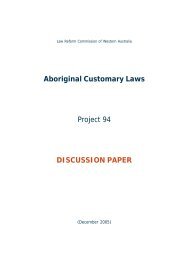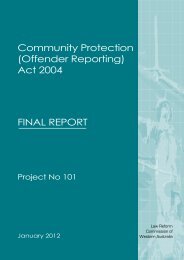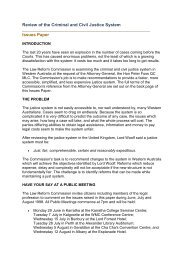Discussion Paper - Law Reform Commission of Western Australia
Discussion Paper - Law Reform Commission of Western Australia
Discussion Paper - Law Reform Commission of Western Australia
You also want an ePaper? Increase the reach of your titles
YUMPU automatically turns print PDFs into web optimized ePapers that Google loves.
protects absent class members and the defendant against large vexatious litigations.<br />
It also attempts to guarantee efficient and affordable justice by ensuring that court<br />
resources are not wasted on unwarranted class actions. However, certification<br />
procedures can also undermine the very principles they seek to uphold. Extensive<br />
certification procedures can mean that much <strong>of</strong> the court’s time is taken up with<br />
preliminary matters rather than the substantive issues or merits <strong>of</strong> a claim. In<br />
addition, class action claimants may face substantial extra costs. The difficulty in<br />
developing reform proposals lies in identifying viable alternatives. Even a regime<br />
that does not formally require certification may experience the same limitations if<br />
the courts become inundated with preliminary interlocutory hearings in class action<br />
proceedings. In light <strong>of</strong> this, it may be preferable to develop a clear certification<br />
procedure so that potential applicants can feel confident in the consistency <strong>of</strong> class<br />
action justice.<br />
Fourfold categorisation system for class actions under Rule 23(b)<br />
5.103 As outlined above, class action claimants must elect an appropriate category <strong>of</strong><br />
class action under which their claim should be certified. The remedies the claimants<br />
are seeking will usually govern this choice and dictate the certification requirements.<br />
Other jurisdictions have not considered the categorisation system to be helpful and<br />
have not adopted it. In particular, in its 1988 report the <strong>Australia</strong>n <strong>Law</strong> <strong>Reform</strong><br />
<strong>Commission</strong> (ALRC) rejected the fourfold categorisation on the grounds that the<br />
categories were overlapping and lacking a coherent conceptual basis. 213<br />
Additional and overlapping certification criterion<br />
5.104 Owing to the overlap between the class action categories, it is arguable that<br />
the Rule 23(b)(3) certification requirements for superiority and predominance<br />
should be common to all class actions. However, if uniform certification procedures<br />
were to be developed, care must be taken to avoid repetition. As already stated, the<br />
need for a typicality requirement under Rule 23(a) has been questioned given the<br />
existence <strong>of</strong> the commonality and adequate representation requirements. In light <strong>of</strong><br />
this, if certification criterion were developed as part <strong>of</strong> <strong>Western</strong> <strong>Australia</strong>n reform<br />
proposals these requirements should avoid overlapping inquiries.<br />
Risk <strong>of</strong> abuse <strong>of</strong> the class action mechanism<br />
5.105 A combination <strong>of</strong> factors has made the Rule 23 class action regime susceptible<br />
to abuse. First, parties to class action litigation are only responsible for their own<br />
costs. Second, representative plaintiffs may be able to enter into contingency<br />
fee agreements that require no payment unless an action succeeds. In effect this<br />
may make class action litigation an attractive ‘no lose’ proposition for potential<br />
claimants. However, access to justice principles makes it essential that a mechanism<br />
be developed to mitigate the costs burden facing representative claimants. Putting<br />
aside the motivations <strong>of</strong> class representatives, permitting court supervision <strong>of</strong> attorney<br />
fee arrangements under Rule 23(h) may go some way to preventing opportunistic<br />
lawyers from taking advantage <strong>of</strong> the class action mechanism. However, United States<br />
court resources may still be unnecessarily expended in the preliminary procedures<br />
required <strong>of</strong> all potential class actions. <strong>Western</strong> <strong>Australia</strong>n reform proposals should<br />
focus on developing mechanisms that balance the principles <strong>of</strong> affordable, efficient<br />
justice with the needs <strong>of</strong> class representatives and their solicitors to avoid similar<br />
abuse.<br />
213. ALRC, Grouped Proceedings in the Federal Court, Report No 46 (1988) 194.<br />
Chapter 5: Overseas Models 83








